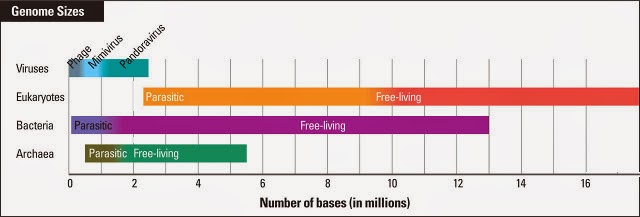Anyone who
reads my blog regularly will know my fondness of viruses (they feature in most
posts). I am particularly curious about giant viruses and have previously
posted about these (link one and two). The giant virus field has recently grown
larger (pun completely intended) with the addition of a new family of even
larger viruses, so I thought it was about time to update the story.
 |
| Pandoravirus |
 |
| Comparison of genome sizes for different domains of life (and viruses) |
Size matters,
but that is by no means the most interesting thing about Pandoraviruses. All
life on Earth is classified into three domains on the so-called tree of life:
eukaryotes, bacteria and archaea. When the genes and proteins of all these
different domains are compared there are strong similarities. Eukaryotes tend
to have the most complexity, but at the core, certain things are the same. For
instance, imagine a protein that has a structure of AABCDD in a bacterium. This
may be the simplest form of that protein. We humans may have a very similar
core structure but have, through evolution, made it more complex – for example,
AAA*BCD*D*EEFG (where the * is denoting small changes to that unit). While this
is different it still carries strong similarities to the simpler, bacterial
protein. These similarities point towards the fact that all life on Earth may
have originated from a single point – the seed for the tree of life – which has
then branched out through evolution to give all the life we see around us.
 |
| Basic diagram of the three domains of life |
Viruses are not
considered living; so do not fit onto the tree of life. However, they do adhere
to the rule of thumb of having strong similarities to other organisms. While
not living, they are still similar to the living. Again, that is the story for
most viruses, but not the Pandoraviruses. Only 7% of the Pandoravirus genome
has similarity to our existing database of proteins and genes. This means 93%
of the proteins Pandoviruses produce have no similarity to anything we have
knowledge about…
This complete
lack of similarity to any other form of life raises something potentially very
fundamental about our view of the world. There is a view that these giant
viruses evolved in a reductionist manner. Evolution is often thought of in a
unidirectional manner, gaining increased complexity. However, this is not a
rule of evolution, the rule of evolution is the selection of advantageous
traits. If becoming less complex provides an advantage then this will be
selected for. The hypothesis surrounding the giant viruses is that they were
once free-living cells (similar to a bacterium for example) that through evolution
lost their self-sufficiency, instead becoming dependent on a host to reproduce
- a trait of a virus. If this were the case then giant viruses would need to be
related to other forms of life, since would have originally been a life form
unto themselves. However, as I've said, there is only 7% similarity between Pandoraviruses
and all other life forms. This means that the ancestors of Pandoraviruses were
probably very different to the ancestors of bacteria, archaea and eukaryotes.
Therefore, where do they fit in our view of evolution? One resolution of this
issue is that maybe there aren't (or at least weren't) only three domains of
life. Pandoraviruses and the other giant viruses could represent the modern day descendants of a forth domain of
life. This is merely an idea with no real concrete evidence, but it seems
exciting to me that as we learn more about these giant viruses, and as we
discover more (which I'm sure we will), our view of life on Earth may need to
change. As has often been the case in biological science, viruses could be
paving the way to a huge shift in our understanding of the world around us.

Two thumbs up! Clear and well written. Thanks for your interest in our work. There is more to come ...
ReplyDeleteJean-Michel
Thanks for the kind words. I look forward to seeing (and writing) about more
ReplyDeletenice
ReplyDelete